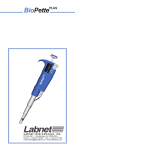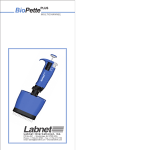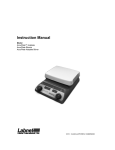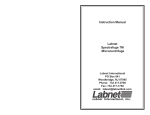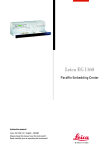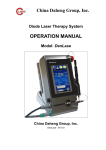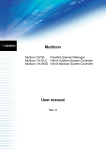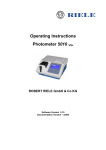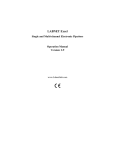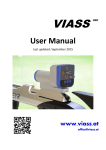Download BioPette Manual - Labnet International
Transcript
BPM/08/2004 v06 31/07/2004 01:06 PM MULTICHANNEL Labnet International, Inc. Page 1 BPM/08/2004 v06 31/07/2004 MULTICHANNEL A A1 A2 C B F D H E 01:06 PM Page 2 BPM/08/2004 v06 31/07/2004 01:06 PM Page 4 MULTICHANNEL 4A 4B G 4C 4D BPM/08/2004 v06 31/07/2004 01:06 PM Page 6 MULTICHANNEL CONTENTS 1 - INTRODUCTION 2 - VOLUME SETTING 3 - METHOD OF PIPETTING 4 - RECOMMENDATIONS 5 - RECALIBRATION 6 - CLEANING AND STERYLIZATION 7 - PIPETTE KIT AND ACCESSORIES 8 - SPARE PARTS The specifications for accuracy and precision given in the following table are obtained using Labnet tips. These figures are only guaranteed when Labnet tips are used. BioPette 8 channel Model SPECIFICATIONS Volume Accuracy [µl] [%] Min 1 5 10 ±8.0 ±4.0 ±2.0 ± 6.0 ± 2.0 ± 1.2 5 25 50 ±4.0 ±3.0 ±1.6 ± 2.5 ± 1.2 ± 0.6 Min 20 100 Max 200 ±3.0 ±1.5 ±1.0 ± 1.5 ± 0.8 ± 0.6 Min ±1.6 ±1.2 ±1.0 ± 1.5 ± 1.0 ± 0.6 BPE-10 Max Min BPE-50 1 - INTRODUCTION The BioPette™ series of adjustable multichannel pipettes have been designed for the filling of laboratory microplates. The pipettes enable precise and simultaneous delivery of 8 or 12 preset-volume doses of liquid. BioPette™ pipettes are produced in four ranges of volumes: 1-10 µl, 5-50 µl, 20-200 µl, 50-300 µl. The BioPette™ pipettes are equipped with a digital counter which shows the pipetting volume. The set volume is visible in the window on the handle. The setting of the volume is done by turning of the pipetting pushbutton knob (Fig. 1A2) or by turning of the black knurled adjustment knob (Fig. 1B) in the right direction. The volume range is shown on the pipetting pushbutton (Fig. 1A1). BioPette™ pipettes should be used with polypropylene disposable tips, to ensure safety and accuracy, (Fig. 1H). The shafts without O-rings ensure the compatibility of the pipettes with a broad assortment of tips, and the special ejector shape reduces the force required for their ejection. In order to protect the user against inadvertent contact with used tips, the pipettes are equipped with tip ejectors, (Fig. 1F). By turning the multichannel module clockwise in relation to the handle, (Fig. 2), it is possible to disable the ejector’s operation in order to avoid accidental use, or to change its position in such a way as to make filling of microplates more convenient. 1 Max BPE-200 BPE-300 Precision [%] 50 150 Max 300 BioPette 12 channel Model SPECIFICATIONS Volume Accuracy [µl] [%] Min 1 5 10 ±8.0 ±4.0 ±2.0 ± 6.0 ± 2.0 ± 1.2 5 25 50 ±4.0 ±3.0 ±1.6 ± 2.5 ± 1.2 ± 0.6 Min 20 100 Max 200 ±3.0 ±1.5 ±1.0 ± 1.5 ± 0.8 ± 0.6 Min ±1.6 ±1.2 ±1.0 ± 1.5 ± 1.0 ± 0.6 BPT-10 Max Min BPT-50 Max BPT-200 BPT-300 Precision [%] 50 150 Max 300 These specifications are obtained in forward mode, using a gravimetric method with the temperature of the distilled water, tips and all other conditions stabilized between 19°C and 21°C. The values given include all components of error due to both normal hand warming and changing of the tips. Performance tests: The pipette is calibrated in accordance with EN ISO 8655. Performance can be verified by checking the pipette using 2 BPM/08/2004 v06 31/07/2004 01:06 PM Page 8 MULTICHANNEL the procedures outlined in the EN ISO 8655 standard. The pipette design enables the user to perform the recalibration process according to the rules presented in section 5. If the knob is accidentally turned too far, ie is set lower than the required value, the process must be repeated. The approach to the set volume must always be made in the order of decreasing value. 2 - SETTING THE VOLUME Volume is set using the pipetting pushbutton (Fig. 1A2) or black adjustment knob (Fig. 1B), while the value is shown on the digital counter. The volume shown by the counter is represented by three digits which should be read from top to bottom. Typical readings are shown in the following table: 3 - METHOD OF PIPETTING Fit the tips onto cones of the multichannel module. In order to put tips on the multichannel shafts hold the pipette vertically and press it against the tips in the rack box, until the shafts retreat about 1.5 mm into the multichannel module. The suspension system of the shafts ensures even and tight sealing of tips. The rolling movement does not have to be performed to seal the tips tightly. The liquid aspirated into the tips should not flow out by gravity from properly fixed tips. While holding the pipette in a vertical position, tips should be immersed in the liquid to a depth of 2-4 mm, and flushed once by drawing a dose of liquid and dispensing it out with slow and steady movement. Next, still holding the pipette vertically, the operator should press the pipetting button until the first resistance point is felt, and immerse the tips in the liquid to the depth of 2-4 mm, (Fig. 3B). Releasing the pipetting button with a slow and uniform movement during 2-3 seconds, the liquid should be drawn into the tips, (Fig. 3B) which should then be lifted above the liquid’s surface. The pipette should next be positioned at an angle of 10-45 degrees in relation to inner walls of destination vessels and tips should be emptied by pressing the pipetting button slowly until the first resistance point is felt, (Fig. 3C). After waiting one second, the pipetting button should be pressed to the second resistance point in order to expel remaining liquid, (Fig. 3D). Then tips should be lifted out from the vessels while maintaining contact between the ends of the tips and the inner walls of the vessel until the pipetting button has been relased, (Fig. 3E). Finally, pressing the ejector button, the operator should separate the tips from multichannel module’s cones, (Fig. 3F). Model BPE-10 BPT-10 BPE-50 BPT-50 BPE-200 BPT-200 BPE-300 BPT-300 Counter readings Set volume Increments 0 3 5 3.5 µl 0.02 µl 0 6 5 6.5 µl 0.10 µl 0 8 5 85.0 µl 0.20 µl 2 5 0 250.0 µl 1.0 µl To attain the maximum accuracy, set volume must be approached from a higher value. If the desired value is lower than the previous value, simply use the knob in the pushbutton (Fig. 1A2) or the black adjustment knob (Fig. 1B) to adjust the value down to 1/3 turn above the required setting. If the desired value is higher than the previous value, use the knob in the pushbutton or the black adjustment ring to adjust the value to 1/3 turn above the required value. The setting should then be performed in the following manner: With the volume set to 1/3 above the required setting, slowly turn the pipetting pushbutton knob or the black adjustment knob to the required volume. 3 4 BPM/08/2004 v06 31/07/2004 01:06 PM Page 10 MULTICHANNEL 4 - RECOMMENDATIONS To achieve maximum safety, precision and reliability, the following principles should be observed: • do not draw liquids without tips fitted on the pipette cones, • do not lay down the pipette with tips filled, • do not draw volumes of liquid exceeding the pipette’s range, • check if the tips are fitted properly, • during operation, the pipette must be held vertically, tips should be immersed in liquid to the depth of 2 to 4 milimeters and the pipetting button should be depressed and released slowly and evenly, • new tips must be pre-rinsed prior to pipetting, by drawing and expelling the liquid to be measured. This is especially important when working with liquids of viscosities and densities different from that of water and in temperatures different from ambient temperature, • when pipeting liquids which tend to wet walls of tips, such as serums, proteins or organic solvents, measuring must be performed much slower than with other liquids, • tips must be replaced with new ones, when changing from one liquid to another, or if drops of liquid remain inside the tips, • after work, the pipette should be stored vertically in a holder with tips removed. 5 - RECALIBRATION BioPette™ pipettes are calibrated by gravimetric method, using Labnet tips and distilled water, at the temperature 20±1°C, according to EN ISO 8655 standard. If during pipette operation you find that the accuracy error (the difference between the real aspirated volume and the preset volume) exceeds the permissible value given in the table in section 1, the pipette recalibration procedure should be carried out. Before starting the recalibration it is necessary 5 to check whether the following requirements have been fulfilled during error determination: • the ambient temperature, and the temperature of the pipette, tips and water was identical • the density of the liquid used is close to that of distilled water • a balance with appropriate sensitivity has been used Volume checked [µl] Balance sensitivity [mg] 0.1 - 10 ≤ 0.001 10 - 100 ≤ 0.01 > 100 ≤ 0.1 • mg/µl conversion factor has been taken into account • the requirements given in sections 3 and 4 have been fulfilled If the above conditions are satisfied and the accuracy error for selected volume given in section 1 exceeds the permissible value, the pipette recalibration procedure should be carried out. The recalibration can be performed within one full turn of the key to the right or to the left only. Recalibration conditions: • Ambient temperature and the temperature of the pipette, tips and liquid should be within the range 20-25°C and stabilized during weighing within ±0.5°C • Measurements should be conducted using distilled water • Balance sensitivity should be suitable for the volume to be controlled Recalibration procedure: • Set the dose volume depending on the pipette volume according to the following table: Range of the pipette volumes [µl] Preset volume [µl] Permissible volumes [µl] Volume change ∆V for full turn of the calibration key [µl] (24 increments) 1 - 10 1 0.92 - 1.08 0.33 5 - 50 5 4.8 - 5.2 1.67 20 - 200 20 19.6 - 20.4 6.30 50 - 300 50 49.2 - 50.8 10.00 6 BPM/08/2004 v06 31/07/2004 01:06 PM Page 12 MULTICHANNEL • Perform three aspiration series (each series should include the aspirations from all channels), weigh each time and calculate the average value of the aspirations. • Calculate average aspirated volume in µl multiplying the average aspiration amount [mg] by the distilled water density coefficient [µl/mg], which depends on temperature and pressure according to the following table: Temperature [°C] Pressure [kPa] 95 101.3 105 20 1.0028 1.0029 1.0029 21 1.0030 1.0031 1.0031 22 1.0032 1.0033 1.0033 23 1.0034 1.0035 1.0036 24 1.0037 1.0038 1.0038 25 1.0039 1.0040 1.0040 If the average aspirated volume exceeds the permissible value, the following should be done: • Remove the pipetting pushbutton, (Fig. 4A) Warning: The pipetting pushbutton consists of 2 parts: the knob (Fig. 1A2) and the pushbutton (Fig. 1A1). After removal of the pushbutton, both parts are separated. • Holding the volume setting knob to protect it against rotation, insert the calibration key into the cuts of the calibration screw, (Fig. 4B) • Turn the key clockwise to reduce the aspirated volume, or counter-clockwise to increase the volume, (Fig. 4C). One full turn of the calibration key changes the pipette aspiration volume by the amount given in the table • Take out the key and fix the pipetting pushbutton (Fig. 4D). The pipetting pushbutton should be fixed by placing the knob on the arbor first (Fig. 1A2) and then the pushbutton (Fig. 1A1). Determine the average aspirated volume. The average volume should be within the permissible range given in the table. If the volume exceeds the values stated, the recalibration procedure should be repeated. 7 6 - CLEANING AND STERILIZATION Cleaning External surfaces of the pipetting pushbutton, the ejector button, the handgrip, shaft and the adjustment knob may be cleaned using a cloth dampened in isopropyl alcohol. Sterilization: The pipette can be sterilized in the autoclave at 121 °C for 20 minutes. After sterilization, the pipette should be dried and cooled to room temperature. It is recommended: - to sterilize the pipette in autoclave with an initial vacuum and drying cycle, - prior to sterilization unscrew the nut connecting the handle and module slightly. After autoclaving these parts should be screwed tight again. The precision of the results should not alter if the pipetting process and autoclaving are carried out as described in this manual. Because a slight change in the accuracy of the dosage may occur, it is recommended to: - check the calibration of the pipette after the initial first, third and fifth autoclaving cycles and then after every 10 autoclaving cycles. 7 - PIPETTE KIT AND ACCESSORIES Pipette kit The pipettes are delivered in the kits including: • Pipette • Instruction manual • Calibration key • Identification labels 8 BPM/08/2004 v06 31/07/2004 01:06 PM Page 14 MULTICHANNEL Accessories Pipettor Tip Choices BPE-10 P 4803-10, 10 µl tips, racked BPE-50 BPE-200 BPT-50 BPT-200 P 4803-200, 200 µl tips, racked BPE-300 BPT-300 P 4803-300, 300 µl tips, racked Pipettor Stand Choices BPE P 5421 Stand for eight channel pipette BPT P 5422 Stand for twelve channel pipette 8 - SPARE PARTS The spare parts for multichannel, (Fig. 1, 4): A: Pipetting pushbutton A1: Pushbutton A2: Knob B: Adjustment knob C: Ejector button D: Piston’s assembly E: Shaft F: Ejector G: Calibration key Can be ordered from a Labnet representative (type of the pipette and name of the part for this pipette should be specified). Warning: The replacement of the plunger requires conducting of calibration procedure according to section 5. Before returning a pipette to a Labnet representative please ensure that the pipette is completely free of any contamination (chemical, microbial or radioactive). Contact Labnet at 732-417-0700, fax: 732-417-1750, email: [email protected] BPM/08/2004 9 10









